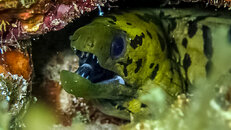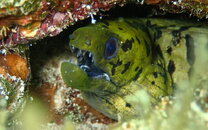You are using an out of date browser. It may not display this or other websites correctly.
You should upgrade or use an alternative browser.
You should upgrade or use an alternative browser.
Let's chat about DSLR vs Point and Shoot - looking for some wisdom / experience
- Thread starter nanohawk
- Start date
Please register or login
Welcome to ScubaBoard, the world's largest scuba diving community. Registration is not required to read the forums, but we encourage you to join. Joining has its benefits and enables you to participate in the discussions.
Benefits of registering include
- Ability to post and comment on topics and discussions.
- A Free photo gallery to share your dive photos with the world.
- You can make this box go away
tarponchik
Contributor
This one is darkish too. Also, like many underwater images, it lacks contrast and this makes it look kinda flat. I also take pictures mostly to document what I've seen, but why not make some images look a little better if you can? This does not take lots of time. I'll give you my workflow in LR5 just in case you kept the RAW file so you can give it a try. The histogram of an image like yours of the undulated moray looks like a shark tooth, so to add contrast and volume you need to stretch it along the X-axis. I never use the CONTRAST slider. Instead, I have my preset I called BASIC UNDERWATER. It does the following:Beauty is in the eye of the beholder hehehehe Hope this isn't too dark for you. After all morays do tend to hide away in dark cavities
View attachment 708137
1. HIGHLIGHTS are pushed all the way to the left, SHADOWS are pushed all the way to the right.
2. CLARITY is pushed to 30, VIBRANCE is pushed to 25.
3. In the Noise panel, DETAIL goes to 20, COLOR goes to 100.
4. The lens distortion is autocorrected.
The next thing I do is to adjust the white balance and crop the image, if needed. Then comes the fun part of adding the contrast. Hold the Alt key pressed and move the WHITES slider to the right. You will see that your image turned completely black but at some point you'll see colored spots. These spots mean loss of details due to overexposure, and you do not want this to happen. So you stop right when you start seeing this colored spots to appear and go back left just a couple of points. Tip: if you moved WHITES to 50 and you still do not see the overexposure spots, this means your image is underexposed. So leave WHITES at 50 and move the EXPOSURE slide to the right holding the Alt key till you see them. Next, press the Alt key and move the BLACKS slider to the left. You will see your image turned white but as you move the slider you'll see colored spots appearing. They mean detail loss due to underexposure. The difference with the WHITES is that it is OK to move the BLACKS slider all the way to the left as much as you want. You do not want any details lost in your main subject but it is OK to make parts of the background like caves and crevices turn completely black.
Now if you look at the histogram, the shark tooth is gone. Instead, it looks sort of like a table mesa, if you've been to NM.
Additional corrections vary. If you want to lower the backscatter and/or the background to be black, like in blackwater images, you move the SHADOWS slider the opposite way, to the left. If you have greenish shadows on the sand you can go to the HSL/COLOR/B&W panel and reduce AQUA and BLUE saturation. If you were using other ISO settings than 200-320 you can adjust noise suppression accordingly, etc.
Anyway, here is what your JPG looks now:
Attachments
It's in a bit of an awkward spot. Basically, in the early 2010s, when Sony, Fujifilm, Olympus and Panasonic went all-in on mirrorless, the DSLR companies - Canon, Nikon and Pentax - went 'hey, we make mirrorless too!', with Pentax making the Q system, Nikon making the 1 system and Canon making the EF-M system. However, none of them took it seriously - Q (a 1/2.3" sensor - smallest sensor ILC cameras ever made) was dropped pretty quick, and Nikon 1 with its 1" sensors followed soon thereafter. Canon is still making the M series cameras, but they only ever released 8 lenses for the mount, leaving it reliant on EF and EF-S glass via an adapter.Does anyone shoot any of the Canon mirrorless stuff? They have a couple cameras that are in the range of the Olympus PEN and M series. In particular the M6 is interesting and there is PDAF and lots more sensor. It's not that much more investment compared to the PEN series. 20mp vs 30.4mp.
I realize we've been talking alot about olympus, but this is a canon group.... lol.
Fast forward to 2018, now Sony full-frame mirrorless is a big thing, eating into DSLR sales, so both Canon and Nikon launch their full-frame mirrorless cameras, in RF and Z mount respectively. Unlike the previous half-hearted attempts, these are meant to supplant and replace the DSLR systems they've been making for decades. Nikon is now making Z-mount cameras in both full-frame (Z5, Z6, Z7, Z9) and APS-C (Z50, Z fc) formats, but Canon is in a sort of limbo - are they going to keep developing the EF-M mount, or will they drop it and replace it with APS-C RF mount cameras, to parallel EF and EF-S SLRs?
In general, Canon, Nikon and Sony don't seem to be treating crop sensor cameras as a priority line of development. Olympus (OM Digital now) is all-in on Micro Four Thirds, and most of Fujifilm's business is in APS-C, with a side line in medium format. Panasonic is focusing mostly on video, with GH series in M43 and S series in full-frame Leica L mount, but the aforementioned trio is putting most of their efforts in full-frame, with APS-C treated more like an afterthought. Sony crop is in a bit of a better position there, as Sony E-mount started as APS-C, getting extended to full-frame a few years later, maintaining full lens compatibility, but the future of Canon and Nikon crop cameras is completely unclear.
Regarding underwater, plenty of people are shooting Sony NEX and A6xxx cameras in a variety of housings, and I personally know one photographer with a Nikon Z50 (he's using the kit 15-45mm with a Nauticam WWL-C), but I haven't seen anybody with a housed M series besides a couple posts on Wetpixel.
tarponchik
Contributor
I've asked this question here awhile ago and apparently there is no such thing as underwater housings for Canon M-series.It's in a bit of an awkward spot. Basically, in the early 2010s, when Sony, Fujifilm, Olympus and Panasonic went all-in on mirrorless, the DSLR companies - Canon, Nikon and Pentax - went 'hey, we make mirrorless too!', with Pentax making the Q system, Nikon making the 1 system and Canon making the EF-M system. However, none of them took it seriously - Q (a 1/2.3" sensor - smallest sensor ILC cameras ever made) was dropped pretty quick, and Nikon 1 with its 1" sensors followed soon thereafter. Canon is still making the M series cameras, but they only ever released 8 lenses for the mount, leaving it reliant on EF and EF-S glass via an adapter.
Fast forward to 2018, now Sony full-frame mirrorless is a big thing, eating into DSLR sales, so both Canon and Nikon launch their full-frame mirrorless cameras, in RF and Z mount respectively. Unlike the previous half-hearted attempts, these are meant to supplant and replace the DSLR systems they've been making for decades. Nikon is now making Z-mount cameras in both full-frame (Z5, Z6, Z7, Z9) and APS-C (Z50, Z fc) formats, but Canon is in a sort of limbo - are they going to keep developing the EF-M mount, or will they drop it and replace it with APS-C RF mount cameras, to parallel EF and EF-S SLRs?
In general, Canon, Nikon and Sony don't seem to be treating crop sensor cameras as a priority line of development. Olympus (OM Digital now) is all-in on Micro Four Thirds, and most of Fujifilm's business is in APS-C, with a side line in medium format. Panasonic is focusing mostly on video, with GH series in M43 and S series in full-frame Leica L mount, but the aforementioned trio is putting most of their efforts in full-frame, with APS-C treated more like an afterthought. Sony crop is in a bit of a better position there, as Sony E-mount started as APS-C, getting extended to full-frame a few years later, maintaining full lens compatibility, but the future of Canon and Nikon crop cameras is completely unclear.
Regarding underwater, plenty of people are shooting Sony NEX and A6xxx cameras in a variety of housings, and I personally know one photographer with a Nikon Z50 (he's using the kit 15-45mm with a Nauticam WWL-C), but I haven't seen anybody with a housed M series besides a couple posts on Wetpixel.
Ikelite and Seafrogs disagree.I've asked this question here awhile ago and apparently there is no such thing as underwater housings for Canon M-series.
I've asked this question here awhile ago and apparently there is no such thing as underwater housings for Canon M-series.

200DLM/A Underwater Housing for Canon EOS M6 Mark II Mirrorless Cameras
A full featured and durable waterproof housing for Canon EOS 200D Rebel SL2 DSLR cameras. Suitable for scuba, snorkel, surf, pool, or any use in or under water.
Ikelite did not get that memo... they are making a few of them.
tarponchik
Contributor
Well, maybe they started making them later.
200DLM/A Underwater Housing for Canon EOS M6 Mark II Mirrorless Cameras
A full featured and durable waterproof housing for Canon EOS 200D Rebel SL2 DSLR cameras. Suitable for scuba, snorkel, surf, pool, or any use in or under water.www.ikelite.com
Ikelite did not get that memo... they are making a few of them.
According to the Ikelite and Canon sites, the original M6 came out in April 2017, by Sept Ikelite had a housing for it. The M6II was introduced in August 2019; the housing was available in 2020.Well, maybe they started making them later.
Blackcrusader
Contributor
I struggle with getting precise focus with macro on my TG-5. I also have not been able to get the two strobes to light correctly when I am a few centimeters from my subject. I was thinking I may need a ring light for those instances?
To get precise focus I use the little green square that will pop up when you press the shutter button. All the photos I am posting were taken before I had my eye lenses replaced so I could not really see if they were in focus or not I used the TG6 focus square then took the shoot. I am using video lights because I like to shoot video as well so I not using strobes.
Blackcrusader
Contributor
This one is darkish too. Anyway, here is what your JPG looks now:
That's great thanks. I have been pretty lazy and not post edited lots of shots. Thanks for those tips. Luckily by that day I had setup my TG6 to shoot in both jpeg and RAW. There is a big difference you see in the jpeg to the ORF file. I am using Olympus Workspace
Thanks for your tips I went a little further in getting the colour of the eye. I have a lot of learning to do with post editing.
Attachments
Similar threads
- Replies
- 0
- Views
- 167
- Replies
- 28
- Views
- 498
- Replies
- 4
- Views
- 485





